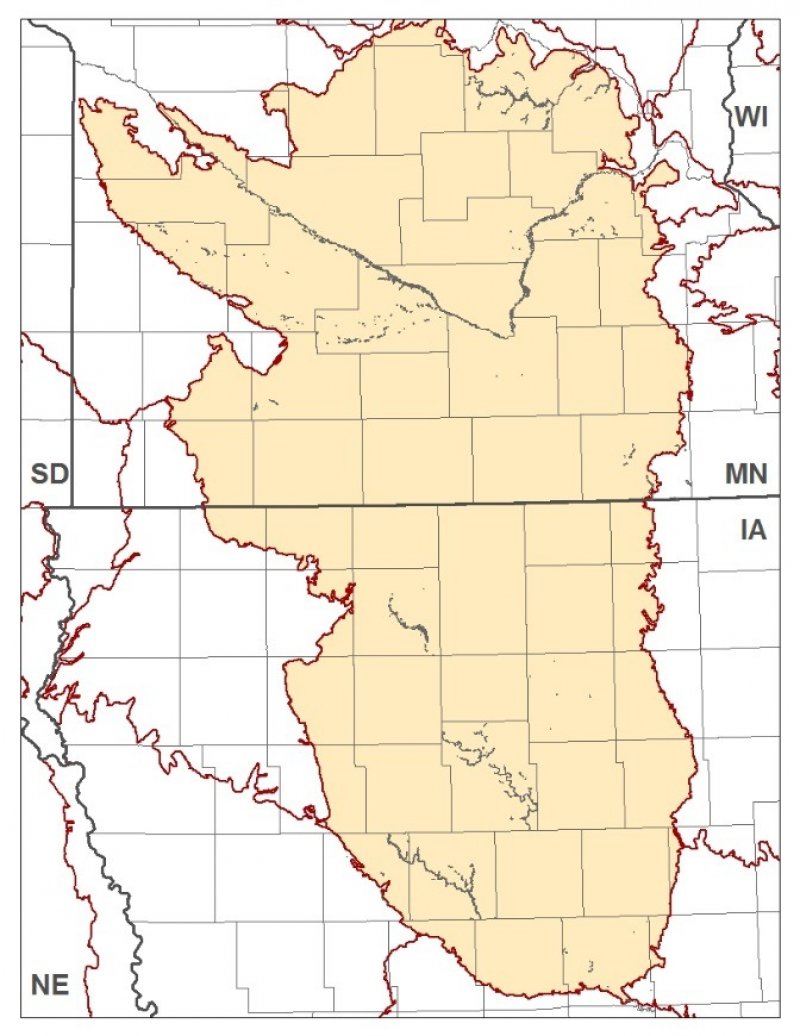
Natural Resources
Conservation Service
Ecological site R103XY034MN
Floodplain Marsh
Last updated: 10/04/2023
Accessed: 12/19/2025
General information
Provisional. A provisional ecological site description has undergone quality control and quality assurance review. It contains a working state and transition model and enough information to identify the ecological site.
MLRA notes
Major Land Resource Area (MLRA): 103X–Central Iowa and Minnesota Till Prairies
MLRA 103 is in Minnesota (56 percent) and Iowa (44 percent) and consists of approximately 18 million acres. It is in the Western Lake Section of the Central Lowland Province of the Interior Plains in an area known as the "Des Moines Lobe" of the Wisconsin-age ice sheet. The MLRA is mostly on a young, nearly level to gently rolling, glaciated till plain that has moraines and glacial lake plains in some areas. The plain is covered with glacial till, outwash, and glacial lake deposits. Recent alluvium consisting of clay, silt, sand, and gravel fill the bottoms of most of the major river valleys. Paleozoic bedrock sediments, primarily shale and limestone, underlie the glacial deposits in most of the area.
The annual precipitation increases from northwest to southeast. Most of the rainfall occurs as high-intensity, convective thunderstorms during the summer. Two-thirds or more of the precipitation falls during the freeze-free period. Snowfall is common in winter. Ground water supplies are adequate for the domestic, livestock, municipal, and industrial needs. Nearly all of this area is farmland, and about four-fifths is cropland.
Classification relationships
Major Land Resource Area (MLRA): Central Iowa and Minnesota Till Prairies (103) (USDA Handbook 296, 2006)
USFS Subregions: North Central Glaciated Plains Section (251B); Upper Minnesota River-Des Moines Lobe (251BA) and Southern Des Moines Lobe (251Be) Subsections (Cleland et al. 2007)
Ecological site concept
The Floodplain Marsh ecological site occurs on floodplains along rivers and drainageways. This site is influenced by hydrologic interactions with the adjacent river which influences the depth of soil saturation. Soils are very poorly drained. Flooding and ponding occurs frequently. The plant community is highly variable depending on hydrology but consists of native wet grasses and scattered hardwoods.
Associated sites
| F103XY032MN |
Loamy Floodplains The Loamy Floodplains ecological site is located on medium textured alluvium throughout MRLA 103. Soils textures include loam, silt loam, sandy loam, and fine sandy loam. Some areas within this ecological site will exhibit long-term flooding (7-30 days). |
|---|---|
| F103XY033MN |
Wet Floodplains The Wet Floodplains ecological site occurs in both floodplains and depressions and is extensive throughout MLRA 103. Soils include both Mollisols and Entisols, and soil drainage class is very poorly drained to poorly drained. Areas within this site flood frequently, and some areas may incur very long periods of flooding (over 30 days). |
Similar sites
| R103XY035MN |
Organic Floodplain Marsh The Organic Floodplain Marsh ecological site is located on floodplains and depressions primarily in the northern portion of MLRA 103. Soils are very poorly drained and derived from organic parent materials. This site can flood and pond frequently for long periods of time. |
|---|
Table 1. Dominant plant species
| Tree |
(1) Ulmus |
|---|---|
| Shrub |
(1) Vitis |
| Herbaceous |
(1) Carex typhina |
Click on box and path labels to scroll to the respective text.
Ecosystem states
| T1A | - | Site disturbance altering the natural plant community |
|---|


